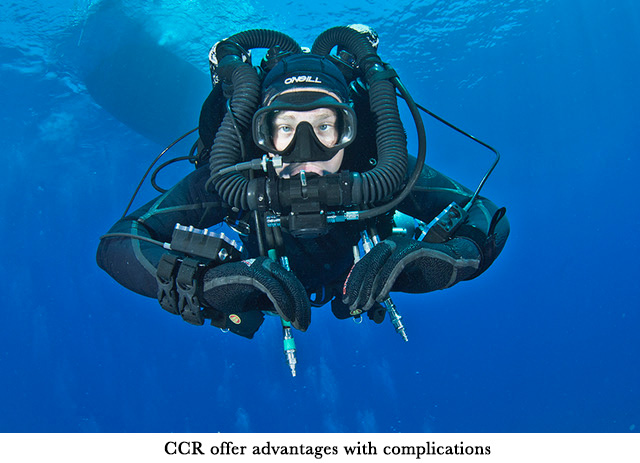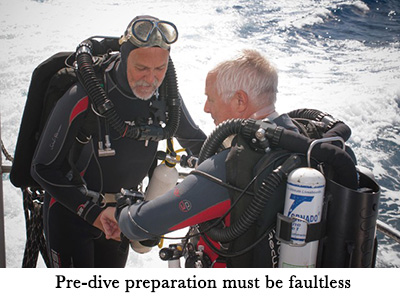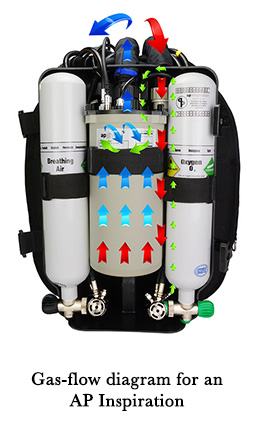Rebreathers: What Every Scuba Diver Needs to KnowContents of this Issue: KM Blue Manta, the Banda Sea, Forgotten Islands, Alor Diving and Hepatitis C: Know the Facts The Chinchorro Banks, Alor, Belize, Roatan Divers Adrift Eight Hours in the Philippines Lionfish-Killing Contests Can Work Rebreathers: What Every Scuba Diver Needs to Know The Most Dangerous Thing You’ll Meet Underwater? Your Boat’s Propeller Fiji and Belize Protect their Reefs The Diving Industry Must Get Rid of Disposable Plastic Mergers, Acquisitions, and Warranties Roatan Park Rangers Face Death Threats Editorial Office: Ben Davison Publisher and Editor Undercurrent 3020 Bridgeway, Suite 102 Sausalito, CA 94965 and know about the diver next to you using one from the February, 2018 issue of Undercurrent
You may never intend to use a closed-circuit rebreather (CCR), but they are becoming surprisingly popular among sport divers. They provide long dive times with minimal gas consumption, while giving an optimum gas mix for changing depths, thereby reducing decompression stops or increasing no-stop times. The first thing you'll notice is that they have two cylinders that are only a quarter the size of a conventional scuba tank. While their bubblefree operation is often used as a selling point, the CCR diver is still very visible and must remain stationary to get close to skittish marine life -- the advantage that an underwater photographer craves.
Divers who spend $5000 or more on their rebreathers naturally want to use it, even if it's not entirely appropriate for their dive. It's rather like the Porsche owner who uses his car for domestic runs rather than for fast drives and country roads. And why not? People can spend their money how they like and get their pleasures in the way they want. However, there have been some high-profile fatalities with rebreathers over the years. If you are an open-circuit recreational scuba diver who finds yourself alongside a CCR diver, there are a few things you should know to have a happy outcome to every dive. A CCR provides a closed breathing loop of which the user becomes a part. After assembling his unit, a CCR diver runs twoway leak tests when preparing his unit for immediate use. If a CCR user appears to say, "That will do," it's not enough. A leak revealed (or ignored) can result in a flooded unit. A CCR diver must perfectly prepare his unit to stay alive. So be aware that CCR divers appear to fiddle with their equipment more than you do before a dive. If you see someone making repeated attempts with these tests and apparently not getting a satisfactory result, yet still going diving, point it out to a dive guide. After spending a lot on a dive trip, some people tend to go diving no matter what. Diving lawyer Rick Lesser calls it the "Sacramento syndrome," after divers who drive hours to California's Pacific Coast to go abalone diving and jump in no matter how dangerous the ocean conditions. Preparing the Electronics A CCR has electronics with oxygen cells that sense the partial pressure of oxygen in the system and keep it constant by adding more oxygen via a servo-operated valve as it is metabolized. When you get to a dive site, don't expect a CCR diver to chuck his unit on his back and plunge into the water as you might. A CCR diver will routinely check important things like oxygen cell readings before a dive. If you're diving in a group with a CCR diver, you might need to be patient for a few minutes. Bubble Free? Not Always. The CCR is a closed breathing circuit that includes the diver's airways and lungs, so at all times the breathing gas is either in his lungs or in the counter-lung of the CCR, a bag in the breathing loop that mirrors the diver's own lungs. The system includes a soda-lime chemical scrubber that cleans the exhaled gas of expired CO2 and reuses the CO2 free gas. Exhaled gas is not vented into the water, so you cannot necessarily tell if a stationary CCR diver is breathing. He just may be studying something and not moving. If you see bubbles emanating from a CCR when a diver is either descending or stationary, bring that to his attention. It might indicate a leak, which can have serious ramifications. However, when a CCR diver is ascending, either he must vent the expanding gas in the system through a dump valve on his unit, or he must exhale it through his nose (it escapes from around the mask). He will be busy because he will also be venting gas from his BC (wing) as well as from his dry suit if he is wearing one. So, you may see an ascending CCR diver in a cloud of bubbles -- then it's not bubble-free diving. Audible Alarms Unlike the conventional open-circuit diver who can run out of air or have his supply cut off for other reasons, a CCR diver can breathe at all times. But, for a CCR diver, it is not if he is breathing but what he is breathing. He will always have some gas in the system, but will it be good enough to support him? The rebreather has two tanks of gas, one with oxygen and one with a diluent gas (usually air in recreational dives) that the rebreather unit mixes according to the ambient pressure, keeping the oxygen pressure in the mix constant. This ensures that the diver breathes the optimum mix of oxygen and diluent gas for his depth. For recreational depths, it's effectively creating nitrox as it goes. However, if the mix becomes hypoxic, i.e., low in oxygen, the diver can still breathe -- until he goes unconscious. There are no early symptoms of the onset of hypoxia, only the audible alarms and those only visible to the user. If you hear an alarm emanating from a CCR during a dive, indicate the user should look at his visual display. During the descent, the oxygen pressure in the mix may become momentarily too high because of increasing ambient pressure. You see, as a CCR diver goes deeper, he needs less oxygen because it's the pressure of oxygen in the mix he breathes that is important, not the percentage of oxygen. As the scuba diver goes deeper, the partial pressure of oxygen in the mix already in the breathing loop increases unless it is metabolized. An audible alarm might warn of an oxygen spike. If it's a momentary spike, it may be of no consequence. However, if the alarm continues, the CCR diver must flush the whole system with the diluent gas (usually air), which produces a lot of escaping bubbles.
Shallow Water Blackout The CCR diver (who wears his oxygen tank on his right side) needs more oxygen in the mix as he ascends (it's mixed with the diluent gas from the tank on his left side). A CCR diver may survive happily at depth with little oxygen remaining in his tank, but there have been too many cases of shallow water blackout because the diver had insufficient oxygen during ascent. If you're diving with a CCR diver, this is something to watch out for. Similarly, a CCR diver on the surface may appear to be breathing easily, but he may have insufficient oxygen in his gas to support him. If so, a CCR unit should sound an alarm, but if an incautious user has switched off the unit before climbing out of the water, he may be in serious trouble. Such a move is contrary to training, but it happens. Oxygen starvation leads to sudden unconsciousness, and the diver may drown. Some CCR divers have foolishly turned off their oxygen while swimming at the surface or before climbing into the boat (presumably to save gas) and have paid the ultimate price. Be aware that a CCR diver could pass out without warning at the conclusion of a dive. What do you do? Immediately get him to the surface and remove his mouthpiece so he can breathe fresh air. He even may need CPR. Floating at the Surface The CCR diver's BC wing can be fully inflated to provide buoyancy at the surface. However, the requirement for a richer oxygen mix in the shallows (with oxygen automatically added to the system) often means that the diver reaches the surface with a counter-lung well inflated, which also provides buoyancy. This only works if he keeps his mouthpiece in and continues to breathe off the unit. However, if he has depleted his oxygen, problems can arise without warning. If you surface next to a CCR diver, encourage him to use his BC (wing) for surface buoyancy. (You might ask him why he has a wing?) It won't matter if he retains his mouthpiece, but if he wants to speak, as most divers do after a dive, he first has to close his mouthpiece before removing it so that no water enters. Carbon Dioxide Poisoning Carbon dioxide (CO2), the waste gas of metabolism, is extremely toxic. A tiny percentage in your lungs gives you the urge to exhale. A higher percentage may lead to confusion and irrational behavior. As previously mentioned, the CCR has a soda-lime chemical scrubber unit to remove CO2, but to be effective, the diver must fill the canister with soda-lime granules to the manufacturer's recommendation and monitor the chemical's life expectancy. With no entirely reliable alarm system to detect harmful levels of CO2, the user cannot be cavalier about the scrubber's duration. A conventional sport diver will find it hard to judge if a CCR diver is suffering from CO2 poisoning, especially if he does not know the diver. So, watch for panicky or irrational behavior. Open Circuit Bail-Out CCR divers habitually carry conventional scuba gear as well, so if they encounter problems with their CCR, they can switch to conventional open circuit gear and make an emergency ascent. (Training agencies introduced this technique when they first developed CCR courses because insurance companies didn't like the perceived risks.) Wearing scuba gear as well is a great idea, but many CCR divers have been pulled from the water with full scuba tanks. Hypoxia (not enough O2) and hypercapnia (too much CO2) does not always give people the time or the ability to make the crucial decision to switch. So don't think if they haven't swapped, they are OK.
Buoyancy Control As a conventional and experienced scuba diver, you probably manage your buoyancy control without a second thought, using your lung volume for immediate and fine adjustments. The lungs of a CCR diver cannot do this because the gas volume is in either them or the counter-lung of the unit, so their buoyancy does not change. They must manage their buoyancy using the BC (wing) attached to the unit. For this reason, CCR divers will tend to swim around an obstruction rather than over it. Fiddling with buoyancy -- that is, repeatedly putting gas into the BC and dumping it out -- will use a lot of gas that is also needed to dilute the oxygen. Similarly, a CCR diver will be reluctant to ascend unnecessarily (e.g., to get close to a marine animal overhead). So don't expect a CCR diver to rise a little to see something you want to show him! Bubble-Free Covert Use A CCR without escaping bubbles allows a user to become covert, provided he keeps still. It also allows him to remain undetected by hiding behind a rock or coral head. That said, a CCR is not Harry Potter's Cloak of Invisibility. The CCR diver is still a big animal, and by moving, he will reveal his presence and frighten off skittish animals. So if you see a CCR diver keeping still and surrounded by scalloped hammerhead sharks, don't join him because you think he has found a good place. Your exhaled bubbles will alarm those animals, and he won't thank you for it. Closed-circuit rebreathers offer advantages, but they don't take prisoners if used incorrectly. A basic understanding of the differences with conventional open-circuit scuba (where you exhale used gas out into the water) can help you have an understanding of what another diver using CCR is doing and what the unique hazards might be. Or whether CCR diving is for you. |

I want to get all the stories! Tell me how I can become an Undercurrent Online Member and get online access to all the articles of Undercurrent as well as thousands of first hand reports on dive operations world-wide
| Home | Online Members Area | My Account |
Login
|
Join
|
| Travel Index |
Dive Resort & Liveaboard Reviews
|
Featured Reports
|
Recent
Issues
|
Back Issues
|
|
Dive Gear
Index
|
Health/Safety Index
|
Environment & Misc.
Index
|
Seasonal Planner
|
Blogs
|
Free Articles
|
Book Picks
|
News
|
|
Special Offers
|
RSS
|
FAQ
|
About Us
|
Contact Us
|
Links
|
3020 Bridgeway, Ste 102, Sausalito, Ca 94965
All rights reserved.




